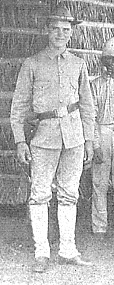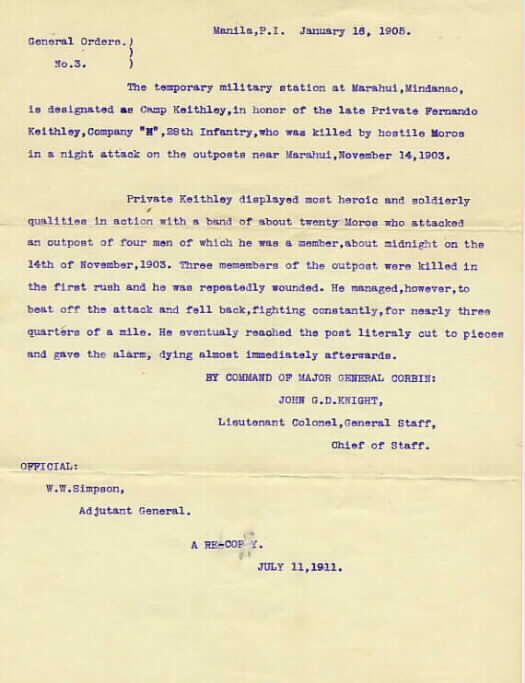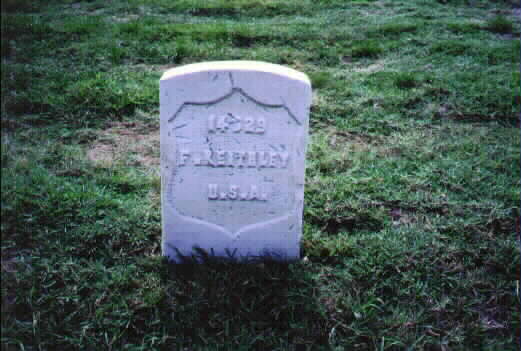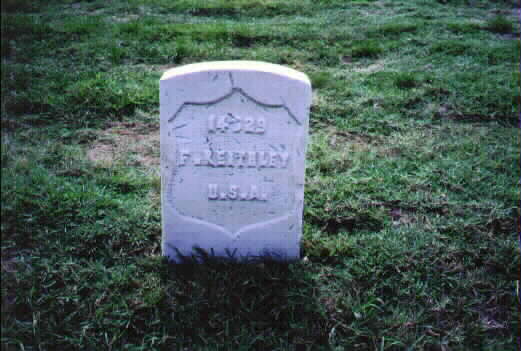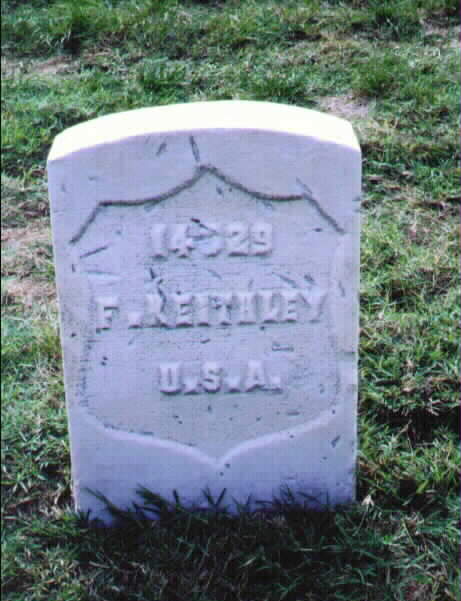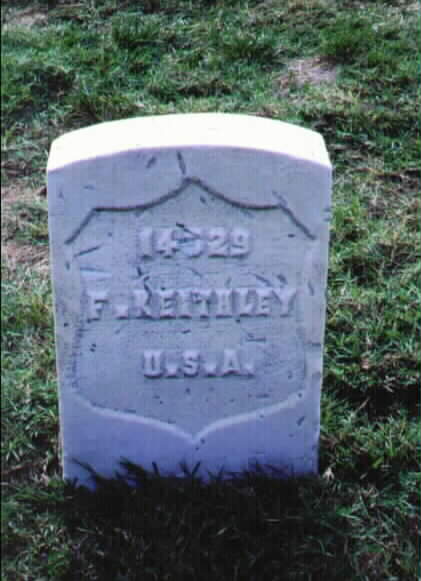Guy Furnando (Fernando) Keithley was a U.S. Army Private who served in the 28th United States Infantry Regiment during the Philippine Insurrection.
Private Keithley was killed in action against Moro tribesmen November 14, 1903 and buried in the Army post of Marahui on the Island of Mindinao, Philippines. At some later date he was re-interred at Arlington National Cemetery.
Guy Furnando Keithley, a native of Taney County, Missouri, was was killed in action by spear wounds inflicted by Moro tribesmen while serving in the United States Army during the Philippine Insurrection in November 1903. His heroic action resulted in an Army garrison be named Camp Keithley after him and possibly an island near Mindanao as well.
Courtesy of Janet Huddle:
This also from Harry I. Stafford:
Furnando was a farm boy, native of Monett, Taney County, Missouri. His Army records state that he was killed as a result of spear wounds while holding off a force of Moro tribesman while he and others were guarding a boat. He became a nationally known war hero and a post was named for him on Mindinao and a bronze plaque with his name was placed in Washington D.C.
From his U.S. Army records at the National Archives I learned that he died of spear wounds from Moro tribesmen. ln November 14, 1903. He was buried in Grave #5 Post Cemetery, Marahui, Mindinao, Philippine Islands on November 15, 1903. He served as an infantryman with Company H, 28th Infantry. Of course, it is possible that he was re-interred to another grave in Arlington at a later time.
From other Keithley information: “His heroism is commemorated by the U.S. Government with a bronze tablet in the Capitol at Washington D.C. Camp Keithley, a strongly fortified post at Marahui P.I. is named in his honor.”
During the Philippine Insurrection, an ancestor of mine was a member of the Company H, 28th Regiment, Infantry. He was stationed on the island of Mindanao, Philippines. During an encounter with Moro tribesmen three of his group were KIA. Private Furnando Keithley was severely wounded but gathered up weapons and killed some twenty of the Moros before perishing himself on November 14, 1903.
His heroism was documented in: “Some Missouri Pioneers their Ancestors, Descendants and Kindred From Other States” by Mary Iantha Castlio, St. Louis Republic, May 29, 1914: Verona, Mo., May 28:
“The heroism in the Philippines of Fernando Keithley, an Osark soldier, is to be commemorated by the United States Government with a bronze tablet, to be placed in the Capitol at Washington, according to a letter received today by Postmaster Harris from the war Department. Keithley passed his boyhood on a farm near here. While a member of Company H, Twenty-eight Infantry, he was killed by Moros at Camp Marohui, November 14, 1903. He was on outpost duty with three comrades when they were attacked. After his companions had been killed he fought the Moros alone, killing twenty of them before they outnumbered him. Camp Keithley, a military post in the Philippines, was named for him”
From the War Department, Washington, D.C., Adjutant General’s Office, July 4,1924.
The above service is verified, adding: “His emergency address was recorded as follows: Willis Keithley, Monett, Mo, or Mrs. M.J. Keithley, Lock Box 281, Monett, Missouri. The name of this soldier is recorded on the records as Furnando Keithley.”
Fernando Keithley’s heroism was also documented in The Swish of the Kris: The Story of the Moros by Vic Hurley. Original publication © 1936 E. P. Dutton & Co., Inc. Filipiniana Reprint Series © 1985 Cacho Hermanos, Inc. You can read the following account at http://www.bakbakan.com/swishk/swk3-18.html.
“Guerilla conditions prevailed. The troops established a fortified camp close to the disturbance area and sent out an outpost composed of Sergeant Stevens and Privates Bowser, Burke and Keithley. The men of the outpost cleared a small area in the dense jungle and settled down to an heroic and terrible sentry duty. In the early morning hours, the rush came. Twenty krismen leaped from the jungle. In the first savage attack, all of the men except Private Keithley were hacked to death on the kris. Keithley received a terrible wound.
This young American soldier performed an almost impossible feat of valor. Gathering the rifles of his dead mates, he fell back slowly, pouring a steady and accurate fire to keep the Moros at bay. For three-quarters of a mile, he fought off the rushes of the krismen, reaching the post with the four rifles, to fall at last before the awful slashes of the kris.
Young Keithley’s experience was duplicated by hundreds of American solders during the course of the Moro campaigns. The Taraca campaigns were ones of close and desperate work against a bush that was alive and slew suddenly, without warning. These early campaigns accomplished nothing, for the destruction of one Moro band was followed by the springing of another across the mountain range. The fighting was terrific and deadly, for it was veiled by a screen of almost impenetrable jungle. The silence of the night was disturbed by the scream of the juramentado and the cutting of tent ropes. The dawn showed a camp of fallen tents with the canvas stained red by the slashes of the kris.
The winning of Mindanao marked an epoch of terror and blood!”
He served in the following named campaign: Mindanao, 4 July 1902-31 December 1904 and 22 October 1905 If you are interested I attached a gif file of the manila campaign army streamer.
Here’s a few more of the information behind the scenes from me, Janet Huddle. Guy Fernando Keithley was my great uncle.
His sister, Lois Keithley, (my grandmother) wrote in her bible:
My brother Fernando Keithley enlisted in the United States Army in 5/13/1901 at Joplin, Missouri. He was in the CA. H 28th Infantry and was wounded and died 11/14/1903 at Mendansa Philippine Island. The name of the camp was changed to Camp Keithley and an island or something else was named Fernando. He was born 10/3/1883.”
His birthdate of 1883 is confirmed by the 1900 Federal Census Barry County, Missouri
This is interesting because Fernando lied about his age when he enlisted. He stated on his enlistment paper dated May 13, 1901 that he was 21 years and one month of age or April 1880. He was actually 17 years, 7 months and 10 days when he enlisted. His mother, Martha Jane Hagler Keithley told her granddaughter, Maxine Henderson that he enlisted without her permission and she had petitioned the Army to send him home. They were arranging to do that when he was killed.
According to his older brother’s obituary, five brothers served in the Spanish-American War or the Philippine Insurrection. We know that Ora Keithley and Luther Keithley, Guy Fernando’s older brothers, served with Teddy Roosevelt in the Rough Riders and saw action in Cuba. They were members of Troop M 1st U.S. Volunteer Cavalry. We suspected that Guy Fernando enlisted because he did not want to be left at home when all his brothers were fighting.
ORA E. KEITHLEY
Graveside military services for Ora E. Keithley, 96, a veteran of the Spanish-American War, will be held at Golden Gate National Cemetery near San Francisco. A native of Missouri, Mr. Keithley served in the Philippines during the war. He was a member of the cavalry and was one of five brothers in the war. http://www.obitcentral.com/obitsearch/obits/ca/ca-sandiego.htm
My father, Maurice Baird, and his twin sister Maxine Henderson, were raised by Fernando’s mother, Martha Jane Hagler Keithley, their grandmother. They were three months premature and would have died if she had not maintained round the clock care for them. They lived with her for 16 years. She told them many stories of her son, which Maxine related to me and other family members. He was known as Guy “Fernando” Keithley in the family. Fernando’s mother, Martha Keithley, my great grandmother, asked Maxine, her granddaughter, to get any medals and information on the medal and honors Guy “Fernando” Keithley received. She felt bad that he died before she could safely bring him home. When Fernando died, Martha Jane Hagler Keithley was living in the backwoods of Missouri and had no way of communicating (no phone and only occasional mail.) She had received a notice that Fernando was supposed to receive a Medal of Honor and other honors, but she never received anything. We have all heard of plaques honoring Fernando, a Keithley Hall in an army base, a Keithley road in the Philippines, Camp Keithley in the Philippines and an island in the Philippines named after Fernando. The family is seeking any information on these. Before Martha Jane Hagler Keithley died, she asked her granddaughter, Maxine Henderson, to find out everything she could about Fernando’s awards and try to get his medals. She never got any of his medals because she lived in such a remote part of Missouri that there was no way to reach her by phone or wire. Before my aunt Maxine died, she asked me to follow up on her grandmother’s wish. She and I want to repay the favor that her grandmother gave her and my father when she saved their lives.
Private Furnando Keithley was severely wounded but gathered up weapons and killed some twenty of the Moros before perishing himself on November 14, 1903. Our family accounts explained that Fernando and his three companions were attacked in the night by a band of Moros (they are followers of Islam). They were killed instantly. He fought his attackers for nearly a mile before reaching the army post. He fell into the arms of his companions and warned them of the attackers before he died shortly afterwards.
KEITHLEY, FURNANDO
- PVT CO H 28TH US INF
- VETERAN SERVICE DATES: Unknown
- DATE OF DEATH: 11/15/1903
- DATE OF INTERMENT: Unknown
- BURIED AT: SITE 14629
ARLINGTON NATIONAL CEMETERY
Michael Robert Patterson was born in Arlington and is the son of a former officer of the US Army. So it was no wonder that sooner or later his interests drew him to American history and especially to American military history. Many of his articles can be found on renowned portals like the New York Times, Washingtonpost or Wikipedia.
Reviewed by: Michael Howard


